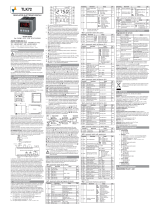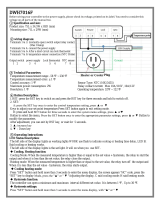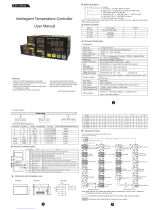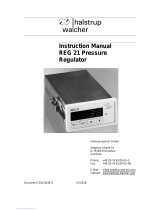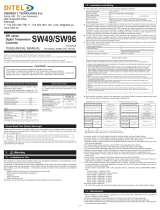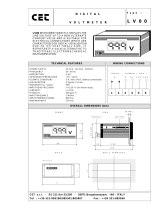
beginning of the scale (0/4 mA, 0/12 mV, 0/1 V o 0/2 V) and, on
par. "FSC", the value that the instrument must visualise at the end
of the scale (20 mA, 50 mV, 60 mV, 5 V or 10 V).
In the case of infrared sensors (TECNOLOGIC IRS-"A" range), by
programming the sensor as "Ir.J" or "Ir.CA", the par. "rEFL" is also
present and it allows the correction of possible measuring errors
caused by the environment lighting and by the reflectivity of the
material. This parameter should be programmed with a high value
if the material to be measured is particularly bright / reflective and
must be reduced if the surface is particularly dark / not reflective,
keeping in mind however that for most materials, the recommended
value is within 1.00 and 0.80.
The instrument allows for measuring calibration, which may be
used to recalibrate the instrument according to application needs,
by using par. “OFSt” and “rot”.
Programming par. “rot”=1,000, in par. “OFSt” it is possible to set a
positive or negative offset that is simply added to the value read by
the probe before visualisation, which remains constant for all the
measurements.
If instead, it is desired that the offset set should not be constant for
all the measurements, it is possible to operate the calibration on
any two points.
In this case, in order to decide which values to program on par.
“OFSt” and “rot”, the following formulae must be applied :
“rot” = (D2-D1) / (M2-M1) “OFSt” = D2 - (“rot” x M2)
where:
M1 =measured value 1
D1 = visualisation value when the instrument measures M1
M2 =measured value 2
D2 = visualisation value when the instrument measures M2
It then follows that the instrument will visualise :
DV = MV x “rot” + “OFSt”
where: DV = visualised value MV= measured value
Example 1: It is desired that the instrument visualises the value
effectively measured at 20° but that, at 200°, it visualises a value
lower than 10° (190°).
Therefore : M1=20 ; D1=20 ; M2=200 ; D2=190
“rot” = (190 - 20) / (200 - 20) = 0,944
“OFSt” = 190 - (0,944 x 200) = 1,2
Example 2: It is desired that the instrument visualises 10° whilst the
value actually measured is 0°, but, at 500° it visualises a 50° higher
value (550°).
Therefore : M1=0 ; D1=10 ; M2=500 ; D2=550
“rot” = (550 - 10) / (500 - 0) = 1,08
“OFSt” = 550 - (1,08 x 500) = 10
By using par. “FiL” it is possible to program time constant of the
software filter for the input value measured, in order to reduce
noise sensitivity (increasing the time of reading).
In case of measurement error, the instrument supplies the power
as programmed on par. “OPE”.
This power will be calculated according to cycle time programmed
for the PID controller, while for the ON/OFF controllers the cycle
time is automatically considered to be equal to 20 sec. (e.g. In the
event of probe error with ON/OFF control and “OPE”=50, the
control output will be activated for 10 sec., then it will be
deactivated for 10 sec. and so on until the measurement error
remains.).
By using par. “InE” it is also possible to decide the conditions of
the input error, allowing the instrument to give the power
programmed on par. “OPE” as output.
The possibilities of par. “InE” are :
= Or : the condition occurs in case of over-range or probe breakage
= Ur : the condition occurs in case of under-range or probe
breakage
= OUr : the condition occurs in case of over-range or under-range
or probe breakage
Using par. “diSP”, located in the group “
]
PAn”, it is possible to set
normal visualization of the SV display which can be the active Set
Point (SP.F), the control power (Pou), the Set Point operating when
there are active ramps (SP.o) or alarm threshold AL1, 2, 3, 4 .
4.2 - OUTPUT CONFIGURATION
The instrument’s outputs can be programmed by entering the
group of parameters “
]
Out” where different parameters (depending
on the type of outputs - digital or analogue - available on the
instrument) are located.
Note: In the following examples, the number of outputs is
generically indicated with n
- DIGITAL OUTPUTS relay or SSR type :
The par. “OnF” can be set for the following functions :
= 1.rEG : Main control output
= 2.rEG : Secondary control output
= ALno : Alarm output normally open
= ALnc : Alarm output normally closed
= On : Output always activated
= OFF : Output deactivated
The coupling outputs number outputs – number alarms can be
made in the group referring to the alarm to the alarm (“
]
AL1, 2, 3,
4”). The option "On" it results usable for the output OUT6 (standard
on all the models) to have an auxiliary supply output for input
sensors
- ANALOGICAL OUTPUTS 0/4..20 mA or 0/2..10 V (only
OUT1,2):
With the parameter “Aorn” it is possible to set the beginning of the
scale used for the output.
This parameter will therefore be set at:
= 0 : if one intends to use the beginning of the scale as equal to 0
(0 mA if the output is 0/4...20 mA, or 0 V if the output is 0/2...10 V)
= no_0 : if one intends to use the beginning of the scale other than
0 (4 mA if the output is 0/4...20 mA, or 2 V if the output is 0/2...10
V)
The parameter “AonF” will be present by which it is possible to
configure the function of the analogical output as:
= 1.rEG : Primary control output
= 2.rEG : Secondary control output
= r.inP : measurement retransmission output
= r.Err : error retransmission output [SP-PV]
= r.SP : Active Set Point retransmission output
= r.SEr : output led by serial communication line of the instrument
= OFF : deactivated output
In the case that analogical output is configured as 1.rEG or 2.rEG
the output signal will be proportional to the control power
calculated by the instrument starting from 0% (output signal
corresponding to the set beginning of the scale) up to 100% (output
signal corresponds to the maximum that can be supplied by the
type of output available).
The analogical control outputs can only be used for PID single
action or dual action controls.
If the set control mode was the ON/OFF type, the analogical output
could only take on the control states 0 % or 100 %.
In the case that the analogical output function should be configured
for the retransmission of the signal, it is therefore necessary to
programme another two parameters which set the minimum and
maximum reference values.
Therefore, in these cases, set the parameter "AonL" with the value
that the instrument must provide the minimum value (0/4 mA or 0/2
V) in output and the value to which the instrument must provide the
maximum value (20 mA o 10 V) to the parameter "AonH" in output.
4.3 - ON/OFF CONTROL (1.rEG)
All the parameters referring to the ON/OFF control are contained in
the group “
]
rEG”.
This type of control can be obtained by programming par."Cont" =
On.FS or = On.FA and works on the output programmed as 1.rEG,
depending on the measure, on the active Set Point “SP”, on the
functioning mode "Func” and on the hysteresis "HSEt".
The instrument carries out an ON/OFF control with symmetric
hysteresis if “Cont" = On.FS or with asymmetrical hysteresis if
“Cont” = On.FA.
The control works in the following way : in the case of reverse
action, or heating (“FunC”=HEAt), it deactivates the output, when
the process value reaches [SP + HSEt] in case of symmetrical
hysteresis, or [SP] in case of asymmetrical hysteresis and is then
ASCON TECNOLOGIC - TLK 94 - OPERATING INSTRUCTIONS - PAG. 5


















